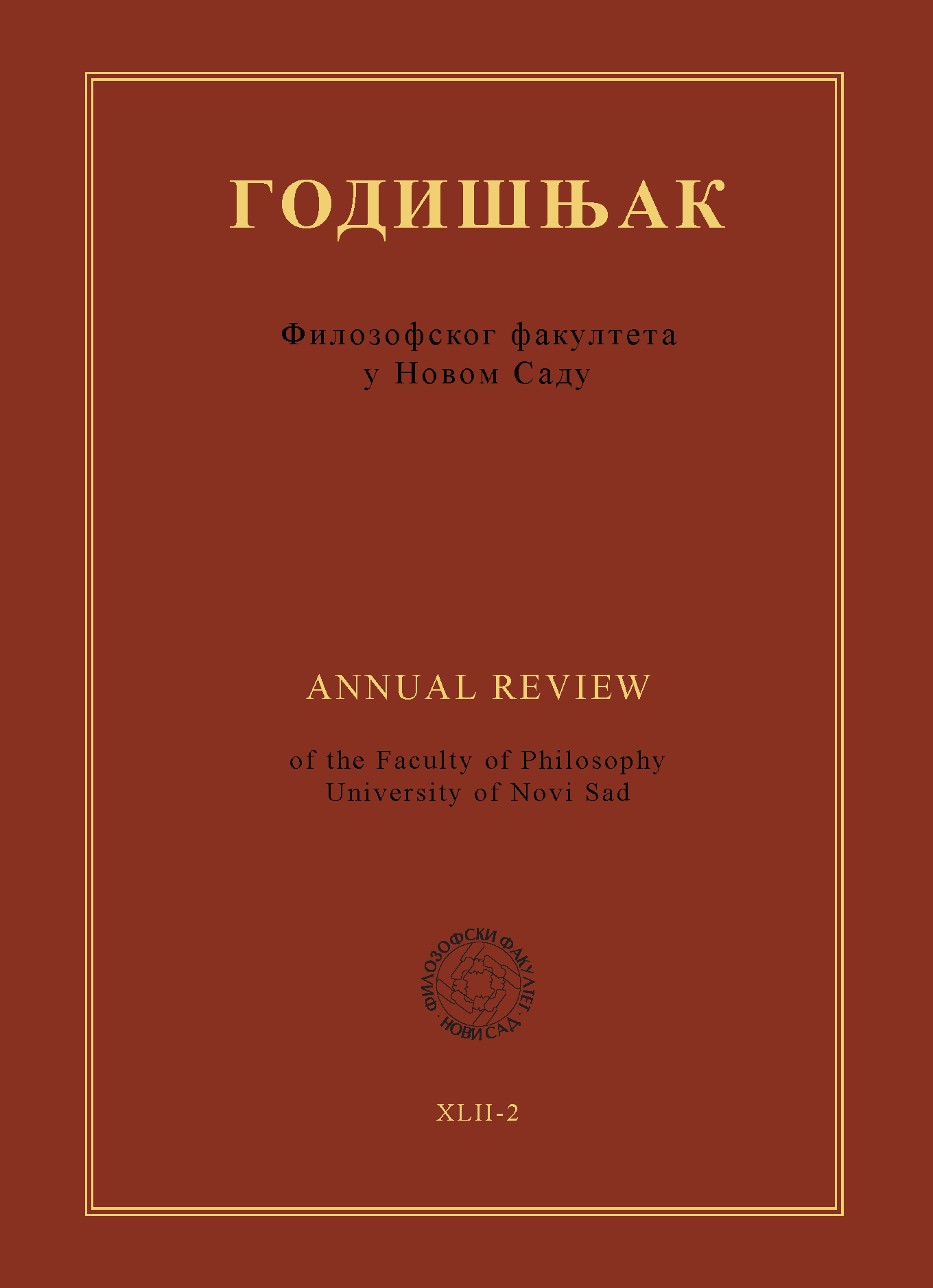VIZUELNE REPREZENTACIJE IZBEGLICA NA "BALKANSKOJ RUTI" U MEDIJIMA U SRBIJI
Главни садржај чланка
Сажетак
U radu analiziramo predstavljanje izbeglica na „Balkanskoj ruti“ u televizijskoj slici i novinskoj fotografiji. Rad ima za cilj da istraži kako se izbeglice predstavljaju u zemlji u kojoj izbeglička kriza nije politizovana i da ispita kako se izbeglice predstavljaju u različitim modalitetima - putem statičnih i pokretnih slika. Uzorak od 125 tekstova i televizijskih priloga prikupljen je tokom sedam dana u martu 2016. godine i tokom marta 2017. godine iz onlajn izdanja novina Blica i Politike, i večernjih dnevnika Radio-televizije Srbije i TV N1. Metoda vizuelne analize zasnovana je na Kresovoj i Van Lijuvenovoj vizuelnoj gramatici, i posebno na analizi vizuelnih toposa predstavljanja. U pogledu narativnih obrazaca predstavljanja identifikuje se pet toposa: drama, kretanje, primanje pomoći, higijena i igra. U konceptualnim obrascima pojavljuju se toposi porodice, dece, usamljenosti, žice i simboličke drugosti. Pozitivnije nego u drugim zemljama, ove su vizuelne predstave izbeglica su kontradiktorne – iako pozivaju na saosećaje i dalje konstruišu drugost i razlike između „nas“ i „njih“.
Downloads
Metrics
No metrics found.
Детаљи чланка
Референце
Banks, J. (2012). Unmasking deviance: The visual construction of asylum seekers and refugees in English national newspapers. Critical Criminology, 20(3), 293–310. doi: 0.1007/s10612-011-9144-x
Baker, P., Gabrielatos, C., KhosraviNik, M., Krzyzanowski, M., McEnery, T., & Wodak, R. (2008). A useful methodological synergy? Combining critical discourse analysis and corpus linguistics to examine discourses of refugees and asylum seekers in the UK press. Discourse & Society, 19(3), 273–306. doi: 10.1177/0957926508088962
Bischoff, C., Falk, F., & Kafehsy, S. (Eds.). (2010). Images of illegalized immigration: towards a critical iconology of politics. Bielefeld: Transcript.
Bleiker, R., Campbell, D., Hutchison, E., & Nicholson, X. (2013). The visual dehumanisation of refugees. Australian Journal of Political Science, 48(4), 398–416. doi: 10.1080/10361146.2013.840769
Berry, M., Garcia-Blanco, I., & Moore, K. (2016). Press coverage of the refugee and migrant crisis in the EU: a content analysis of five European countries. Retrieved from http://orca.cf.ac.uk/id/eprint/87078.
Caviedes, A. (2015). An Emerging ?European? News Portrayal of Immigration? Journal of Ethnic and Migration Studies, 41(6), 897–917. doi: 10.1080/1369183X.2014.1002199
Colombo, M. (2017). The Representation of the “European Refugee Crisis” in Italy: Domopolitics, Securitization, and Humanitarian Communication in Political and Media Discourses. Journal of Immigrant & Refugee Studies, 1–18. doi: 10.1080/15562948.2017.1317896
Crespo Fernández, E., & Martínez Lirola, M. (2012). Lexical and visual choices in the representation of immigration in the Spanish press. Spanish in Context, 9(1), 27–57. doi: 10.1075/sic.9.1.02cre
Dinham, P. (10. 1. 2017). Food queue with echoes of Europe's dark past: Freezing migrants wait for aid in Belgrade today in pictures chillingly similar to those from the Second World War. Daily Mail. URL: http://www.dailymail.co.uk/news/article-4107102/Belgrade-migrants-wait-food-pictures-similar-Second-World-War.html#ixzz4mRV37cjr
Hodge, R., & Kress, G. (1988). Social Semiotics. Cambridge: Polity
Höijer, B. (2004). The discourse of global compassion: The audience and media reporting of human suffering. Media, Culture & Society, 26(4), 513–531. doi: 10.1177/0163443704044215
Holmes, S. M., & Castaneda, H. (2016). Representing the ?European refugee crisis? in Germany and beyond: Deservingness and difference, life and death: Representing the ?European refugee crisis? American Ethnologist, 43(1), 12–24. doi: 10.1111/amet.12259
Horsti, K. (2016). Visibility without voice: Media witnessing irregular migrants in BBC online news journalism. African Journalism Studies, 37(1), 1–20. doi: 10.1080/23743670.2015.1084585
Jenni, K., & Loewenstein, G. (1997). Explaining the identifiable victim effect. Journal of Risk and Uncertainty, 14(3), 235–257.
Khosravinik, M. (2010). The representation of refugees, asylum seekers and immigrants in British newspapers: A critical discourse analysis. Journal of Language and Politics, 9(1), 1–28. doi:10.1075/jlp.9.1.01kho
Kress, G. (2010). Multimodality: A social semiotic approach to contemporary communication. London: Routledge.
Kress, G., & Van Leeuwen, T. (2001). Multimodal Discourse: The Modes and Media of Contemporary Communication. Arnold: London.
Kress, G., & Van Leeuwen, T. (2006). Reading images: The grammar of visual design. 2nd Edition. London: Routledge.
Lalić, S. (2016). Uloga medija u oblikovanju javnog mnijenja prema izbjeglicama i tzv. izbjegličkoj krizi. Zagreb: GONG - Kuća ljudskih prava Zagreb. URL: http://www.dostajemrznje.org/wp-content/uploads/2016/10/Uloga-medija-u-oblikovanju-javnog-mnijenja-prema-izbjeglicama.pdf
Lenette, C., & Cleland, S. (2016). Changing faces: Visual representations of asylum seekers in times of crisis. Creative Approaches to Research, 9(1), 68.
Lenette, C., & Miskovic, N. (2016). ‘Some viewers may find the following images disturbing’: Visual representations of refugee deaths at border crossings. Crime, Media, Culture, doi: 10.1177/1741659016672716
Manchin, D., & Mayr, A. (2012). How To Do Discourse Analysis: A Multimodal Introduction. London: Sage.
Mannik, L. (2012). Public and private photographs of refugees: the problem of representation. Visual Studies, 27(3), 262–276. doi: 10.1080/1472586X.2012.717747
Martinez Lirola, M. (2014). Exploring visual dysphemisms in pieces of news related to immigrant minors in a Spanish newspaper. Visual Communication, 13(4), 405–427. doi: 10.1177/1470357214541741
O'Halloran, K. L. (2004). Multimodal Discourse Analysis. Systemic-Functional Perspectives. London: Continuum.
Pozitivan stav prema migrantima ima 43 odsto građana Srbije (19. 6. 2017). Insajder. URL: https://insajder.net/sr/sajt/vazno/5357/Pozitivan-stav-prema-migrantima-ima-43-odsto-gra%C4%91ana-Srbije.htm
Reisigl, M. & Wodak, R. (2001). Discourse and discrimination: Rhetorics of Racism and Antisemitism. London: Routledge.
Rheindorf, M., & Wodak, R. (2017). Borders, Fences, and Limits?Protecting Austria From Refugees: Metadiscursive Negotiation of Meaning in the Current Refugee Crisis. Journal of Immigrant & Refugee Studies, 1–24. doi: 10.1080/15562948.2017.1302032
Richardson, J., & Colombo, M. (2013). Continuity and change in anti-immigrant discourse in Italy: An analysis of the visual propaganda of the Lega Nord. Journal of Language and Politics, 12(2), 180–202. doi: 10.1075/jlp.12.2.02ric
Scheufele, D. (1999). Framing as a theory of media effects. Journal of Communication, 42(1): 103–122.
Szörényi, A. (2006). The images speak for themselves? Reading refugee coffee‐table books. Visual Studies, 21(1), 24–41. doi.org: 10.1080/14725860600613188
Tomanić Trivundža, I. (2015). Press Photography and Visual Framing of the News. Ljubljana: Faculty of Social Sciences.
Van Dijk, T. A. (1988) News as Discourse. Hillsdale: Lawrence Erlbaum.
Van Leeuwen, T. (2008). Discourse and Practice: New Tools for Critical Discourse Analysis. Oxford University Press.
Vuletić, V., Stanojević, D., Vukelić, J., & Pešić, J. (2016). Studija o izbeglicama – Srbija 2016. Beograd: Friedrich Ebert Stiftung - Centar za primenjena društvena istraživanja. URL: http://library.fes.de/pdf-files/bueros/belgrad/12928.pdf.
Wright, T. (2002). Moving images: The media representation of refugees. Visual Studies, 17(1), 53–66. doi.org: 10.1080/1472586022000005053




